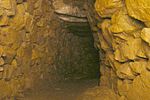Poldhu is a small area in south Cornwall, England, UK, situated on the Lizard Peninsula; it comprises Poldhu Point and Poldhu Cove. Poldhu means "black pool" in Cornish. Poldhu lies on the coast of Mount's Bay and is in the northern part of the parish of Mullion; the churchtown is 2 kilometres (1.2 mi) to the south-east. On the north side of Poldhu Cove is the parish of Gunwalloe and the village of Porthleven is a further 7 kilometres (4.3 mi) to the north.Poldhu Point became the site of one of the main technological advances of the early twentieth century when, on 12 December 1901, a wireless signal was sent by Thomas Barron in Poldhu to St. John's, Newfoundland, and received by Marconi. The technology was a precursor to radio, television, satellites and the internet, with the earth station at Goonhilly Downs a nearby example.The beach at Poldhu was heavily mined during World War II to prevent any prospect of a German force landing there. As an unfortunate result, on 24 April 1943, Royal Air Force Volunteer Reserve members Mair Myfannwy Richards and Reginald Thomas Smith both died instantly when Mair trod on an unmarked mine.In January 2016 Poldhu Cove was inundated with thousands of pink plastic bottles, brought onto the beach with successive tides. The National Trust said it believed a container had gone overboard from a ship, during the stormy weather.








